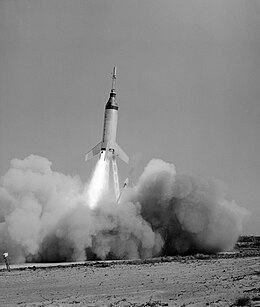
Project Mercury was the first human spaceflight program of the United States, running from 1958 through 1963. An early highlight of the Space Race, its goal was to put a man into Earth orbit and return him safely, ideally before the Soviet Union. Taken over from the US Air Force by the newly created civilian space agency NASA, it conducted twenty uncrewed developmental flights, and six successful flights by astronauts. The program, which took its name from Roman mythology, cost $2.25 billion adjusted for inflation. The astronauts were collectively known as the "Mercury Seven", and each spacecraft was given a name ending with a "7" by its pilot.

Splashdown is the method of landing a spacecraft by parachute in a body of water. It was used by crewed American spacecraft prior to the Space Shuttle program, and by the SpaceX Dragon spacecraft starting in 2010, and is planned for use by the upcoming Orion Multipurpose Crew Vehicle. It is also possible for the Russian Soyuz spacecraft to land in water, though this is only a contingency. The only example of an unintentional crewed splashdown in Soviet history is the Soyuz 23 landing.

Mercury-Redstone 3, or Freedom 7, was the first United States human spaceflight, on May 5, 1961, piloted by astronaut Alan Shepard. It was the first crewed flight of Project Mercury. The project had the ultimate objective of putting an astronaut into orbit around the Earth and return him safely. Shepard's mission was a 15-minute suborbital flight with the primary objective of demonstrating his ability to withstand the high g-forces of launch and atmospheric re-entry.

Mercury-Atlas 6 (MA-6) was the first American orbital spaceflight, which took place on February 20, 1962. Piloted by astronaut John Glenn and operated by NASA as part of Project Mercury, it was the fifth human spaceflight, preceded by Soviet orbital flights Vostok 1 and 2 and American sub-orbital flights Mercury-Redstone 3 and 4.

Mercury-Atlas 7, launched May 24, 1962, was the fourth crewed flight of Project Mercury. The spacecraft, named Aurora 7, was piloted by astronaut Scott Carpenter. He was the sixth human to fly in space. The mission used Mercury spacecraft No. 18 and Atlas launch vehicle No. 107-D.

Mercury-Atlas 9 was the final crewed space mission of the U.S. Mercury program, launched on May 15, 1963 from Launch Complex 14 at Cape Canaveral, Florida. The spacecraft, named Faith 7, completed 22 Earth orbits before splashing down in the Pacific Ocean, piloted by astronaut Gordon Cooper, then a United States Air Force major. The Atlas rocket was No. 130-D, and the Mercury spacecraft was No. 20. This mission marks the last time an American was launched alone to conduct an entirely solo orbital mission.

Big Joe 1 (Atlas-10D) launched an uncrewed boilerplate Mercury capsule from Cape Canaveral, Florida on 9 September 1959. The purposes of the Big Joe 1 were to test the Mercury spacecraft ablative heat shield, afterbody heating, reentry dynamics attitude control and recovery capability. It was also the first launch of a spacecraft in Project Mercury.

Mercury-Atlas 3 (MA-3) was an unmanned spaceflight of the Mercury program. It was launched unmanned on April 25, 1961 at 16:15 UTC, from Launch Complex 14 at Cape Canaveral, Florida. The Mercury capsule contained a robotic "mechanical astronaut". Mercury spacecraft No. 8 and Atlas No. 8 100-D were used in the mission.

Mercury-Atlas 1 (MA-1) was the first attempt to launch a Mercury capsule and occurred on July 29, 1960 at Cape Canaveral, Florida. The spacecraft was unmanned and carried no launch escape system. The Atlas rocket suffered a structural failure 58 seconds after launch at an altitude of approximately 30,000 feet (9.1 km) and 11,000 feet (3.4 km) down range. All telemetry signals suddenly ceased as the vehicle was passing through Max Q. Because the day was rainy and overcast, the booster was out of sight from 26 seconds after launch, and it was impossible to see what happened.

Mercury-Redstone 1A (MR-1A) was launched on December 19, 1960 from LC-5 at Cape Canaveral, Florida. The mission objectives of this uncrewed suborbital flight were to qualify the spacecraft for space flight and qualify the system for an upcoming primate suborbital flight. The spacecraft tested its instrumentation, posigrade rockets, retrorockets and recovery system. The mission was completely successful. The Mercury capsule reached an altitude of 130 miles (210 km) and a range of 235 miles (378 km). The launch vehicle reached a slightly higher velocity than expected - 4,909 miles per hour (7,900 km/h). The Mercury spacecraft was recovered from the Atlantic Ocean by recovery helicopters about 15 minutes after landing. Serial numbers: Mercury Spacecraft #2 was reflown on MR-1A, together with the escape tower from Capsule #8 and the antenna fairing from Capsule #10. Redstone MRLV-3 was used. The flight time was 15 minutes and 45 seconds.

Mercury-Redstone 2 (MR-2) was the penultimate test flight of the Mercury-Redstone Launch Vehicle prior to the first crewed American space mission in Project Mercury. It was launched at 16:55 UTC on January 31, 1961 from LC-5 at Cape Canaveral, Florida. Mercury spacecraft No. 5 carried a chimpanzee named Ham on a suborbital flight, landing in the Atlantic Ocean 16 minutes and 39 seconds after launch.

Mercury-Redstone BD was an uncrewed booster development flight in the U.S. Mercury program. It was launched on March 24, 1961 from Launch Complex 5 at Cape Canaveral, Florida. The mission used a boilerplate Mercury spacecraft and Redstone MRLV-5.

Mercury-Scout 1, or MS-1, was a United States spacecraft intended to test tracking stations for Project Mercury flights. It grew out of a May 5, 1961 NASA proposal to use Scout rockets to launch small satellites to evaluate the worldwide Mercury Tracking Network in preparation for manned orbital missions. The launch of Mercury-Scout 1 on November 1, 1961 was unsuccessful, and the satellite failed to achieve orbit.

Little Joe 1 (LJ-1) was a failed launch of a Little Joe of the NASA, a solid fuel rocket that was designed for a Max Q abort and Launch Escape System test for Mercury capsule. The objective was to determine how well the escape rocket would function under the most severe dynamic loading conditions anticipated during a Mercury-Atlas launching.

Mercury-Atlas 2 (MA-2) was an unmanned test flight of the Mercury program using the Atlas rocket. It launched on February 21, 1961 at 14:10 UTC, from Launch Complex 14 at Cape Canaveral, Florida.

The Beach Abort was an unmanned test in NASA's Project Mercury, of the Mercury spacecraft Launch Escape System. Objectives of the test were a performance evaluation of the escape system, the parachute and landing system, and recovery operations in an off-the-pad abort situation. The test took place at NASA's Wallops Island, Virginia, test facility on May 9, 1960. In the test, the Mercury spacecraft and its Launch Escape System were fired from ground level. The flight lasted a total of 1 minute, 16 seconds. The spacecraft reached an apogee of 0.751 kilometres (2,465 ft) and splashed down in the ocean with a range of 0.97 kilometres (0.6 mi).Top speed was a velocity of 436 metres per second (976 mph). A Marine Corps helicopter recovered the spacecraft 17 minutes after launch. The test was considered a success, although there was insufficient separation distance when the tower jettisoned. Mercury Spacecraft #1, the first spacecraft off McDonnell's production line, was used in this test. Total payload weight was 1,154 kilograms (2,544 lb).

The Little Joe 1B was a launch escape system test of the Mercury spacecraft, conducted as part of the U.S. Mercury program. The mission also carried a female rhesus monkey named Miss Sam in the Mercury spacecraft. The mission was launched January 21, 1960, from Wallops Island, Virginia. The Little Joe 1B flew to an apogee of 9.3 statute miles (15.0 km) and a range of 11.7 miles (18.9 km) out to sea. Miss Sam survived the 8 minute 35 second flight in good condition. The spacecraft was recovered by a Marine helicopter and returned to Wallops Island within about 45 minutes. Miss Sam was one of many monkeys used in space travel research.

Little Joe 5 was the November 8, 1960, unmanned atmospheric test flight of the Mercury spacecraft, conducted as part of the U.S. Mercury program. The objective was to test a production Mercury capsule (#3) and the launch escape system during an ascent abort at maximum dynamic pressure. The mission was launched from Wallops Island, Virginia. Sixteen seconds after liftoff, the escape rocket and the tower jettison rocket both fired prematurely. Furthermore, the booster, capsule, and escape tower failed to separate as intended. The entire stack was destroyed on impact with the Atlantic Ocean. The Little Joe 5 flew to an apogee of 10.1 miles (16.2 km) and a range of 13 miles (20.9 km). Some capsule and booster debris was recovered from the ocean floor for post flight analysis.

Little Joe 5A was an unmanned launch escape system test of the Mercury spacecraft, conducted as part of the U.S. Mercury program. It was an attempted re-test of the failed Little Joe 5 flight. The mission used production Mercury spacecraft #14 atop a Little Joe booster rocket. The mission was launched March 18, 1961, from Wallops Island, Virginia. The LJ-5 failure sequence was repeated when capsule escape rocket again ignited prematurely with the capsule remaining attached to the booster. In this flight however, a ground command was sent to separate the capsule from the booster and escape tower. This allowed the main and reserve parachutes to deploy and the capsule was recovered with only minor damage. It would be used again on the subsequent Little Joe 5B mission, in a third attempt to achieve mission objectives. The Little Joe 5A flew to an apogee of 7.7 miles (12 km) and a range of 18 miles (29 km). The mission lasted 5 minutes 25 seconds. Maximum speed was 1,783 miles per hour (2,869 km/h) and acceleration was 8 G (78 m/s²).

Little Joe was an unmanned United States solid-fueled booster rocket used for eight launches from 1959-1960 from Wallops Island, Virginia to test the launch escape system and heat shield for Project Mercury capsules, as well as the name given to the test program using the booster. The first rocket designed solely for manned spacecraft qualifications, Little Joe was also one of the pioneer operational launch vehicles using the rocket cluster principle.





















